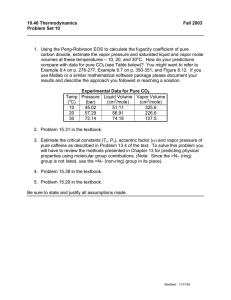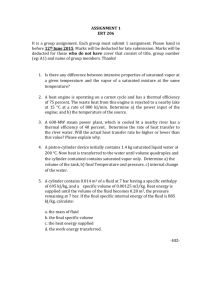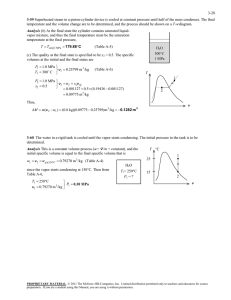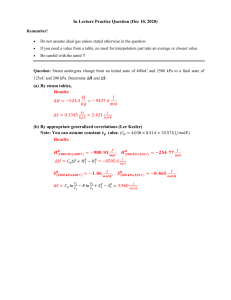Properties of Pure Substances: Thermodynamics Textbook Chapter
advertisement
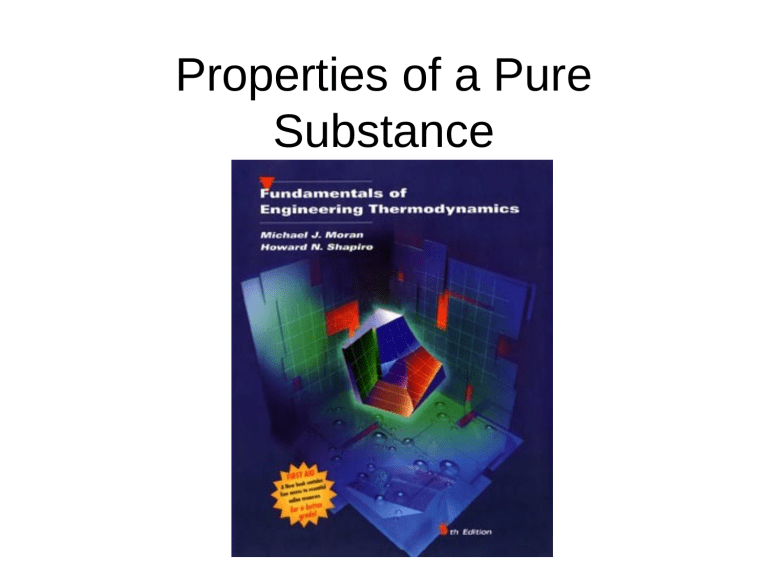
Properties of a Pure Substance Properties of Pure Substance: Unit 3 Applying energy balance to a system of interest requires knowledge of the properties of the system and how the properties are related. The objective of this chapter is to introduce property relations relevant to engineering thermodynamics. As part of the presentation, several examples are provided that illustrate the use of the system energy balance introduced in unit 2 together with the property relations considered in this unit. Properties of Pure Substance Phase Change Study the events that occur as a pure substance undergoes a phase change. To begin, consider a closed system consisting of a unit mass (1 kg) of liquid water at 20C contained within a piston– cylinder assembly, as illustrated in the Fig. above. This state is represented by point l on the other Fig. Suppose the water is slowly heated while its pressure is kept constant and uniform throughout at 1.014 bar. Properties of Pure Substance Saturation Temperature Saturation temperature is the temperature at which liquids start to boil or the temperature at which vapor begin to condense. The saturation temperature of a given substance depends upon its existing pressure. It is directly proportional to the pressure, i.e., it increases as the pressure is increased and decreases as the pressure is decreased. Examples: Water boils at 100C at atmospheric condition (?kPa) Water boils at ?C at a pressure of 1000 kPa. Steam condenses at ?C at 10 Mpa. Steam condenses at 40C at ? Mpa. Properties of Pure Substance Subcooled Liquid A sub-cooled liquid is one, which has a temperature lower than the saturation temperature corresponding to the existing pressure. Example: Liquid water at 60C and 1.014 bar is a sub cooled liquid. Why? From the steam tables, the saturation temperature at 1.014 bar is 100C. Since the actual temperature of liquid water of 60C is less than 100C, therefore, it is a sub cooled liquid. Properties of Pure Substance Compressed Liquid A compressed liquid is one, which has a pressure higher than the saturation pressure corresponding to the existing temperature. Question: Is the liquid water at 2 bar and 100C a compressed liquid? From the steam tables, Psat at 100C = 1.014 bar. Comparing: The actual liquid water pressure of 2 bar is greater than Psat at 100C. therefore, it is a compressed liquid. Properties of Pure Substance Saturated Liquid A saturated liquid is a liquid at the saturations (saturation temperature or saturation pressure), which has temperature equal to the boiling point corresponding to the existing pressure. It is a pure liquid, i.e., it has no vapor content. Examples: Liquid water at 100C and 1.014 bar. Liquid water at 233.9C and 3 Mpa. Liquid water at 324.8C and 12 Mpa. From Steam Tables: tsat at 101.4 kPa = 100C tsat at 3 Mpa = 233.9C tsat at 12 Mpa = 324.8 C Properties of Pure Substance Vapor Vapor is the name given to any gaseous phase that is in contact withy the liquid phase, or that is in the vicinity of a state where some of it might be condensed. Saturated Vapor A saturated vapor is a vapor at the saturation conditions (saturation temperature and saturation pressure). It is 100% vapor, i.e., has no liquid or moisture content. Examples: Steam (water vapor) at 100C and 101.4 kPa. Steam at 212.4C and 2 Mpa. Steam at 352.4C and 17 Mpa. Properties of Pure Substance Superheated Vapor A superheated vapor is a vapor having a temperature higher than the saturation temperature corresponding to the existing pressure. Example: Steam at 200C and 101.4 kPa. 200C > (tsat at 101.4 kPa = 100C) Steam at 300C and 5 Mpa. 300C > (tsat at 5 MPa = 264C) Properties of Pure Substance Degree of Superheat, SH The degree of superheat is the difference between the actual temperature of superheated vapor and the saturation temperature for the existing pressure. In equation form: SH = Actual superheated temperature - tsat at existing pressure Example: Determine the degrees of superheat of superheated steam at 200C and 101.4 kPa. From the steam tables: tsat at 101.4 kPa = 100 C SH = 200 – 100 = 100 C Properties of Pure Substance Degrees Sub cooled, SB The degrees sub cooled of a sub-cooled liquid is the difference between the saturation temperature for the given pressure and the actual sub cooled liquid temperature. SB = tsat at given p – actual liquid temperature Example: Determine the degrees sub cooled of liquid water at 90C and 101.4 kPa. tsat at 101.4 kPa = 100C SB = 100C - 90C = 10 C Properties of Pure Substance Wet Vapor A wet vapor is a combination of saturated vapor and saturated liquid. Quality, x The quality of wet vapor or wet steam is the percent weight that is saturated vapor. by Percent Moisture, y The percent moisture of wet vapor is the percent by weight that is saturated liquid. Properties of Pure Substance Let m = mass of wet vapor mg = mass of the saturated vapor content of wet vapor mf = mass of the saturated liquid content of wet vapor then, m = mg + mf Following the definitions of quality (x) and percent moisture (y), x = mg (100%) m y = mf (100%) m Properties of Pure Substance For saturated liquid: y = 100% x = 0% For saturated vapor: x = 100% y = 0% For wet vapor: 0 < x < 100 0 < y < 100 but x + y = 100 in percent form and x + y = 1 in decimal form Properties of Pure Substance Latent Heat of Vaporization The latent heat of vaporization of a pure substance is the amount of heat added to/remove from the substance in order to convert it from saturated liquid/saturated vapor to saturated vapor/saturated liquid with the temperature remaining constant. It is inversely proportional to the temp of the substance. Example: Determine the latent heat of vaporization of water at: (a) 100C, (b) 200C, and (c) 300C. From the steam tables: hfg at 100C = ? kJ/kg hfg at 200C = ? kJ/kg hfg at 300C = ? kJ/kg Properties of Pure Substance Critical Point The critical point represents the highest pressure and highest temperature at which liquid and vapor can coexist in equilibrium. The state of water at critical conditions whether it is saturated liquid or saturated vapor is known. Hence, the latent heat of vaporization of water at this condition is either zero or undefined. Properties of Pure Substance Sensible Heat Heat that causes change in temperature without a change in phase. Examples: Heat added in raising the temperature of steam from 100C at 101.4 kPa to 150C. Heat removed in lowering the temperature of water from 90C to 80C. Latent Heat Heat that causes changes in phase without change in temperature. Examples: Heat added in converting 1 kg of water at 100C and 101.4 kPa to 1 kg of steam at 100C and 101.4 kPa. Properties of Pure Substance Properties of Wet Steam Subscripts Used/Symbols Used f – represents properties of saturated liquid g – represents properties of saturated vapor fg – represents to a change by evaporation v – specific volume, m3/kg s – specific entropy, kJ/kg.K u – specific internal energy, kJ/kg h – specific entalphy, kJ/kg vg = vf + vfg hg = hf + hfg sg = sf + sfg ug = uf + ufg vfg = vg – vf hfg = hg – hf sfg = sg – sf ufg = ug - u Properties of Pure Substance v = specific volume of its saturated liquid content + specific volume of its saturated vapor content v = yvf + xvg From v = yvf + xvg But y = 1-x Then v = (1-x)vf + xvg = vf- -xvf + x(vf + vfg) = vf- -xvf + xvf + xvfg v = vf + xvfg Properties of Pure Substance or x = 1-y v = yvf + (1 – y)vg = yvf + vg – yvg = vg – y(vg – vf) v = vg – yvfg similarly, h = hf + xhfg s = sf + xsfg u = uf + xufg or or or h = hg – yhfg s = sg – ysfg u = ug – yufg Properties of Pure Substance NOTE: At saturated conditions, p and t are dependent on one another and therefore, are considered as one independent property. At superheated conditions, p and t are independent from each other and therefore, are considered as two independent properties. Quality could not be more than 100 % and percent moisture could not be lower than 0%. Properties of Pure Substance Sample problem 1.) Specify whether the steam is wet, dry, or superheated for the following conditions: t = 200C, p = 1.44 MPa t = 220C, p = 2.318 MPa p = 1.0 MPa, s = 6.672 kJ/kg K p = 3.0 Mpa, t = 234C t = 250C, v = 54.2 x 10-3 m3/kg p = 11.0 Mpa, h = 2805 kJ/kg p = 4.0 Mpa, s = 5.897 kJ/kg K p = 15.0 MPa, t = 310C Properties of Pure Substance Sample problem 2.) What are the specific volume, internal energy, enthalpy and entropy of steam at 1.50 Mpa, and 250C? Properties of Pure Substance Sample problem 3.) At 250C a mixture of saturated steam and liquid water exists in equilibrium. If the specific volume of the mixture is 0.04159 m3/kg, calculate the following: (a) percent moisture (b) enthalpy (c) entropy. Properties of Pure Substance Sample problem 4.) Steam at a pressure of 0.90 Mpa has entropy of 4.9678 kJ/kg (K). What are the specific volume, internal energy, and enthalpy? Properties of Pure Substance Sample problem 5.) Steam at a temperature of 300C has a specific volume of 0.09765 m3/kg. Determine the pressure, specific internal energy, enthalpy, and entropy. Properties of Pure Substance Sample problem 6.) A 0.0856-m3 drum contains saturated water and saturated vapor at 360C. (a) Find the mass of each if their volumes are equal. What is the quality? (b) Find the volume occupied by each if their masses are equal. Processes of Vapors Processes of Vapors Although vapors and ideal gases have similarity in forms and in their processes, all of the equations that are based on the characteristic equation of a perfect gas or on Joules Law, for instance, are not generally applicable to vapors. But the general energy equation, P1 + k1 + U1 + Wf1 + Q = P2 + k2 + U2 + Wf2 + W And the simple energy equation, Q = U2 – U1 + Wn are not based on any limitations concerning the substance. They are applicable, therefore, to processes of vapors as well as of gases. Therefore, in this chapter, compare the equations obtained with analogous one for a gas. This way we can avoid the improper application of a perfect gas equation to a vapor. Processes of Vapors Constant Pressure Process (a) The process on the pv and Ts plane Defining the condition of the substance Point 1 is in the liquid region and the condition of the substance is “subcooled” or “compressed” liquid Point f lies on the saturation curve and is therefore saturated liquid at a given pressure or temperature. Point m is in wet region, is a mixture of liquid and vapor. A quality x and a pressure or temperature generally defines the condition of the substance. Point g is on the saturation vapor curve. A pressure or temperature defines the state or condition of the substance. Point 2 in the superheat region is generally, but not necessarily, defined by giving its temperature and pressure. Processes of Vapors (b) The work of a reversible nonflow constant pressure process. Wn = pdv is the area on the pv plane under the constant pressure process. At p = C Wn = p dv = p(v2 – v1) [unit mass] For steady flow process, the work Ws is Ws = h1 – h2 - K + Q Processes of Vapors (c) Transferred heat, Q. from the simple energy equation, Q = u2 – u1 + Wn [unit mass] For steady flow and nonflow processes, Q = u2 – u1 + p(v2 – v=) = u2 – u1 + p2v2 – p1v1 = h2 – h1 where h1 = hf1 + x1hfg1 If the change in specific internal energy is desired, we use the relation, u2 – u1 = (h2 – p2v2 ) – (h1 – p1v1) Sample Problems •Steam with the specific volume of 0.09596 m3/kg undergoes a constant pressure process at 1.50 Mpa until the specific volume becomes 0.1325 m3/kg. What are (a) the final temperature, (b) u, (c) s, and (e) Q? Processes of Vapors Constant Volume Process (a) The process on the pv and Ts planes. Fig. 2-3. Reversible Constant Volume (Isometric) Process. Point 1 is in the superheat region and point 2 in the wet region so that, v1 = v2 = vf2 + x2vfg2 Processes of Vapors (b) Work of the nonflow process, Wn. Wn = 0 (c) Transferred heat, Q. Q = u2 – u1 + Wn [unit mass] Q = u2 – u1 and u2 = uf2 + x2ufg2 or Q = (h2 – p2v2) – (h1 – p1v1) Sample Problems • One kg of steam at 260oC and with an enthalpy of 1861 kJ/kg is confined in a rigid container. Heat is applied until the steam becomes saturated. Determine (a) Q, (b) h, (c) s, and (d) the final temperature. Processes of Vapors Isothermal Process (a) The process on the pv and Ts planes Processes of Vapors (b) Work of a nonflow process, Wn. From the simple energy equation, Wn =Q -u (unit mass) (c) Transferred heat Q from the Ts plane. Q = Ts [ unit mass] = T(s2 - s1) and s2 = sf2 + x2sfg2 (d) Work of steady flow process, Ws Ws = Q - h - K Sample Problems •Steam at 200oC and with an entropy of 5.6105 kJ/(kg)(k) expands isothermally to 0.5 MPa. For 5 kg (a) what are S, H, and U? Determine Q and W (b) for a nonflow process, (c) for a steady flow process with K = 0 Processes of Vapors Adiabatic processes of vapor (a) The reversible process on the pv and Ts planes. A reversible adiabatic process is constant entropy process and also known as “isentropic process”. Processes of Vapors In an isentropic process, no heat is transferred (Q = 0) and the change in the entropy of the substance is also zero (S = 0). For a nonflow process, Q = u + Wn = 0 [unit mass] with Q = 0, Wn = -u Wn = u1 – u2 And for steady flow process, with P = 0 K1 + h1 + Q = K2 + h2 + Ws with Q = 0, Ws = h1 – h2 - K With K = 0, Ws = h1 – h2 Processes of Vapors (b) The irreversible process on the pv and Ts planes. Process 1-2 is the corresponding reversible adiabatic or isentropic process (ideal expansion) Process 1-2’ is the irreversible adiabatic process (actual expansion). Processes of Vapors For a nonflow process with Q = 0, Q = 0 = u’ + Wn [unit mass] Wn = -u’ where u’ = u1 – u’2 and for steady flow process, Ws = h1 – h2 reversible process Ws’ = h1 – h2’ irreversible process Processes of Vapors Efficiency of the process, η Expansion on h-s plane. η = h1 - h2’ x 100% h1 - h2 h2’ – h2 is known as the process internal reheat and s2’ – s2 is the irreversibility of the process. Processes of Vapors Compression on the h-s plane. Efficiency of compression, Sample Problems • One kiliogram of steam expands isentropically from 2.0 MPa and 360C to 90C. find the final quality and the work for nonflow and steady flow process. Processes of Vapors Polytropic Process (a) The process on the pv plane Figure 2- 1. Rversible Polytropic Process (b) Work of the nonflow process, Wn Polytropic process is defined by the equation, pvn = C Wn = pdv Wn = p2v2 – p1v1 1-n Processes of Vapors (c)Transferred heat, Q Q = u+ Wn = u2 – u1 + (p2v2 – p1v1)/(1 – n) (d) Work of steady flow process, Ws Ws = Q - h - K Also, Ws = -vdp = [n(p2v2 – p1v1)] / (1 – n) = (n) (Wn) Sample Problems • Expand 2 kg of steam at 15 bar, 320C, into the wet region to 100C in a polytropic process where pv1.21 = C. Determine (a) y2, (b) H, (c) S, (d) nonflow and steady flow work, and (e) Q. Processes of Vapors THROTTLING PROCESS (a) The process on the Ts and hs planes. Irreversible Throttling Process. Throttling process is a fully irreversible steady flow adiabatic process with no work being done. Processes of Vapors From the general energy equation with K = 0, Q = 0 and W = 0, we have, h1 = h2. the general defining equation for throttling is: h2 = h1 = hf1 = x1hfg1 For approximate computation h2 = hg + cpt where hg is the specific enthalpy of saturated vapor at p2 or t2 t = SH, degrees of superheat = t2 – (tsat at p2) cp = the specific heat of steam
